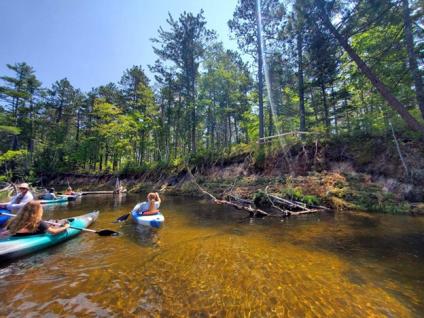Restoration continues on Au Train River
MICHIGAN—During the brief but glorious summer in the Upper Peninsula, people want to hit the water—and the Hiawatha National Forest’s Au Train River Canoe Trail offers a relaxing four- to six-hour canoe trip for those seeking a slower-paced adventure.
That easy, beginner-friendly pace makes the Au Train River a very popular outing. During the summer months, the river regularly sees 800 to 1,000 paddlers every weekend.
Over time, that volume of use accelerates erosion on the riverbanks, which increases sediment in the water and degrades fish habitat. So, for the last five years, the Hiawatha has partnered with organizations like the Great Lakes Climate Corps, YouthWork and Trout Unlimited to restore riverbanks and mitigate human-caused erosion.
This year, the Hiawatha again teamed up with one of their longtime partners, the Great Lakes Climate Corps, to build upon past restoration work with a new five-year project (internal link). Twelve sites along the river will be enhanced and several miles of fish habitat will be improved. Day use sites will be upgraded to be more inviting to recreators by providing comfortable spots where they can take a break with minimal impact on the land, while user-made sites will be closed off using coir logs (coconut fiber logs), fascines (vegetation bundles) and saplings to discourage paddlers from eroding sites further. This allows the sites to eventually revert to their natural state.
“Erosion is a natural process on the sand riverbed, so we should expect to see a little sand accruing on the outside of river bends each spring when the water rises after snowmelt,” said Lindsey Goss, a hydrologist with the forest. “However, when you have a lot of paddlers, when they see that sand, that’s an area where they want to congregate. And they come in, and all that foot traffic damages soil that’s already deteriorated, which accelerates the amount of erosion that’s happening at an exponential rate.”
Paddlers can help by heeding Forest Service signs directing them away from certain areas, and by being mindful of where they choose to bank.
“If you see an area that has sparse vegetation, but enough sand to bank, don’t step there,” said Goss. “It’s already a fragile system, and all it takes is a few footprints and you’ve already uprooted that vegetation and you’ve accelerated the rate of erosion.”
Goss said these collaborative restoration partnerships are invaluable to improving and stewarding the land for both environmental and recreational longevity.
“We’re just one agency and we’ve got limited staff here at the Forest Service, so any time we can expand our workforce through agreements and partnerships, it really helps with the big picture to restore and maintain our public lands,” said Goss.
Partnerships like these also provide opportunities for new conservationists to explore career paths while making a difference. “It feels amazing,” said Alec Bush, a crew leader with the Great Lakes Climate Corps. “A lot of people I’ve talked to that have worked here can go back a couple years later and still see the work that they’ve done. I’m excited to come back in a few years and see how things are holding up.”

